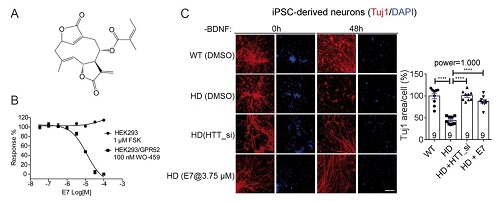Huntington’s disease (HD) is neurodegenerative disorder. HD is caused by the mutation of the HTT gene encoding the mutant HTT protein (mHTT) with expanded polyglutamine tract (polyQ). Lowering the levels of disease-causing proteins is an attractive treatment strategy for neurodegenerative disorders. Lowering the mHTT level ameliorates mHTT toxicity in multiple models.
Recently, a research paper entitled “Targeting GPR52 lowers mutant HTT levels and rescues Huntington’s disease-associated phenotypes” was published in Brain. The work was conducted by Fudan University and the Shanghai Institute of Materia Medica (SIMM) of the Chinese Academy of Sciences.
In this study, Prof. LU Boxun’s lab from Fudan University discovered that a striatal-enriched G protein-coupled receptor, GPR52, regulates the mHTT levels ex vivo and in vivo. Knocking-down GPR52 rescues HD-associated phenotypes in HD fly and mouse models and patient induced pluripotent stem cell (iPSC)-derived neurons, indicating that GPR52 might be a potential drug target for the treatment of HD.
Prof. XIE Xin’s lab from SIMM carried out a high-throughput screen and identified a specific antagonist of GPR52, compound E7. This compound reduces mHTT levels and rescues HD-associated behavioural phenotypes in a knock-in HD mouse model expressing endogenous mHTT. These data provide the proof-of-concept evidence of treating Huntington’s disease by reducing soluble mHtt via GPR52 blockade with compound drugs.
Currently, SIMM Prof. HU Youhong’s lab has been focusing on optimizing the compound
E7 so as to improve the antagonist activity on GPR52.
This study was conceived and supervised by Prof. LU and XIE. Students from Fudan University and SIMM shared the first authorship.
The study was supported by the Ministry of Science and Technology of China, the National Natural Science Foundation of China and Fudan-SIMM Joint Innovation Fund.
Link to the article:https://academic.oup.com/brain/advance-article/doi/10.1093/brain/awy081/4955844

Figure:A. Structure of the newly identified GPR52 antagonist E7. B. The dose-response curve of E7 in blocking GPR52. C. the Huntington’s disease patient iPSC-derived striatal neurons show neuronal shrinkage and processes loss, both phenotype could be rescued by E7 treatment. (Image courtesy of Brain)
Contact person:
Prof. XIE Xin
Email: xxie@simm.ac.cn
(Credit: XIE Xin; Editor: PAN Peihua)

